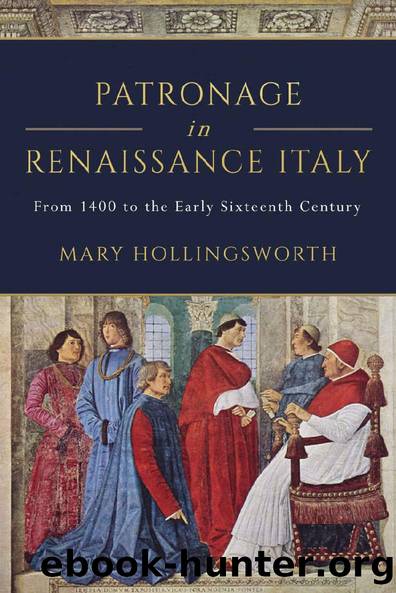Patronage in Renaissance Italy by Mary Hollingsworth

Author:Mary Hollingsworth [Hollingsworth, Mary]
Language: eng
Format: epub
Publisher: Lume Books
Published: 2020-10-28T00:00:00+00:00
14
Urbino
High up in the mountains of central Italy, the tiny fortress town of Urbino was an unlikely setting for one of the leading centres of the Italian Renaissance. The town was not prosperous but, situated on the northern border of the papal states, it was strategically important. Urbino was nominally a papal fief, owned by the Montefeltre who had acquired it in lieu of debts owed to them by the Papacy.[1] The family were famous as soldiers, earning their living as condottieri. The succession of Federigo da Montefeltro as Count of Urbino (1444â82) marked a turning point in Urbinoâs fortunes and the transformation of this insignificant hill-top town into one of the outstanding courts of fifteenth-century Italy.
Federigo da Montefeltro had been educated at the Gonzaga court in Mantua where he had been taught by the humanist, Vittorino da Feltre. He inherited his fatherâs company of troops and embarked on an immensely successful career as a condottiere, fighting at various times for Venice, Naples, Florence and the Papacy.[2] Francesco Sforza employed him for 60,000 ducats a year in peace time and 80,000 for war.[3] He accepted an offer of 165,000 ducats for himself and his troops to fight in the War of Ferrara (1482â4) and was reputed to have turned down a bid of 80,000 ducats for his neutrality from Venice.[4] His considerable talents and prestige were rewarded when Pope Sixtus IV created him Duke of Urbino in 1474 and Edward IV of England made him a Knight of the Garter in the same year.[5] The loss of his right eye in a tournament gave him a striking appearance and contemporaries described him as well read. One of his employers, Pope Pius II, reported a conversation they had had on the subject of classical warfare, adding that he disagreed with Federigoâs derisive judgement on the Trojan war.[6] By all accounts he was prudent, practical and cunning as a fighter and a benevolent ruler.[7] He died in 1482 of a fever, possibly malaria, at the age of 60, while fighting in Ferrara.
Federigo had travelled widely in Italy and he had been a comrade, or opponent, of many of the rulers of the peninsulaâs secular courts. His ducal status put him on a level with the Este in Ferrara or the Gonzaga in Mantua. But Urbino lacked the grandeur expected of someone of his rank. Federigo set out to acquire the trappings of princely prestige and to create a court that would impress his peers. He employed humanists to advertise his reputation. Unlike the Sforza regime in Milan or the Aragonese kings in Naples, Federigo had no compelling need to legitimize his power. But he did need to display his achievements and promote his prestige. The humanists attached to his court wrote laudatory accounts of his career and promoted him, with reason, as a major patron of the arts. Federigo spent conspicuously on grand architecture and lavish decoration. He commissioned a programme of church building and decoration in Urbino and dramatically enlarged his family palace.
Download
This site does not store any files on its server. We only index and link to content provided by other sites. Please contact the content providers to delete copyright contents if any and email us, we'll remove relevant links or contents immediately.
The Japanese by Christopher Harding(1085)
Watercolor With Me in the Forest by Dana Fox(753)
A Theory of Narrative Drawing by Simon Grennan(742)
The Story of the Scrolls by The Story of the Scrolls; the M(725)
Glittering Images: A Journey Through Art From Egypt to Star Wars by Camille Paglia(717)
Boris Johnson by Tom Bower(620)
This Is Modern Art by Kevin Coval(597)
The Art and Science of Drawing by Brent Eviston(588)
Frida Kahlo by Frida Kahlo & Hayden Herrera(584)
AP Art History by John B. Nici(575)
Banksy by Will Ellsworth-Jones(569)
War Paint by Woodhead Lindy(551)
Van Gogh by Gregory White Smith(547)
Draw More Furries by Jared Hodges(544)
About Looking by John Berger(543)
Scenes From a Revolution by Mark Harris(542)
Ecstasy by Eisner.;(535)
100 Greatest Country Artists by Hal Leonard Corp(523)
Young Rembrandt: A Biography by Onno Blom(512)
